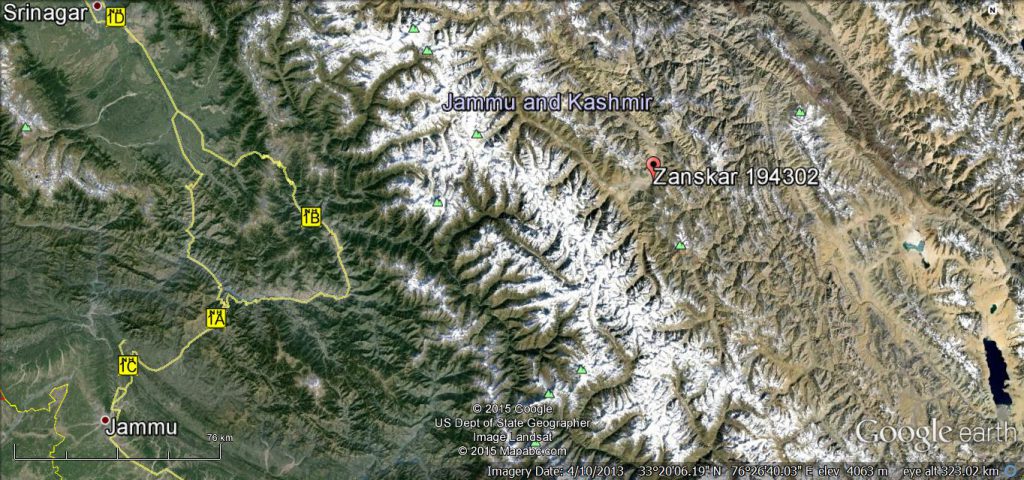Experts in the Himalayan state of Jammu and Kashmir in northern India have warned that a disaster is looming in the eastern part of the state due to the formation of a huge lake – which continues to increase in size – following the blockade of a river by a massive landslide.
No effective measure has been initiated so far to mitigate the disaster and prevent the lake from bursting and causing destruction downstream. Local officials said on Monday that the information about the landslide is sketchy as no ground survey has been carried out yet to assess the situation. They said that the causes of the landslide are not known yet though some estimates about the extent of the artificial lake and the height and length of the blockade were made on the basis of an aerial survey and satellite imagery.
The landslide blocked the river Phutkal in Ladakh’s Zanskar region on January 15, leading to the formation of the lake, in which the water is accumulating all the time, as shown by the images of the National Remote Sensing Centre of the Indian Space Research Organisation.
District administration officials as well as member of parliament from Ladakh, Thupstan Chewang, alerted both the state and the central government about the impending disaster right away. “Though I was satisfied by the initial response of the Prime Minister’s Office (PMO) as an expert team was constituted to take stock of the situation, unfortunately no follow up action has been taken so far,” Chewang told thethirdpole.net.

“We can’t wait for the disaster to strike. Given the loose soil of the area, it can’t hold water for long; so it is a matter of time. The disaster can strike any time,” the MP added, expressing his apprehension that Zanskar was not the only area at risk – some parts of district headquarters Leh including the Numbo-Buzgo power plant could also be affected.
Experts agree, saying the lake could cause a huge disaster if necessary measures are not taken to drain it immediately. “The water needs to be driven out slowly by the use of available resources like skillful and careful dynamite blasting. This is something which should be considered for avoiding the disaster,” Sandip Pandita, who teaches Geology in Jammu University, told thethirdpole.net.
He said that Ladakh is known for its loose soil and the occurrence of such landslides should not be surprising. “The area, being a cold desert, is devoid of any vegetation and thus prone to landslides especially in near rivers,” Pandita explained. “In Ladakh, as we have seen during the August 2010 floods, the water collects the debris and becomes saturated making it more dangerous.” The 2010 floods killed over 250 people in Ladakh and caused damage to property worth millions of dollars.
Landslide and the lake
Estimates about the size of the lake have been made through an aerial survey and satellite imagery as the area is isolated. Additional Deputy Commissioner Moses Konzum, who has been appointed as the nodal officer in charge of tackling the potential disaster, said that the blockade is around 500 metres in length and 50 metre high – the resultant lake is already 10 kilometres across in some places and expanding all the time.
Konzum said 192 residents of 30 households in seven villages in Kargil district (in the Zanskar belt) will be affected if the lake bursts its banks – so will some parts of Leh district.
He also said the state government has started making arrangements to shift the people who are likely to be affected. “We are thinking of shifting these people to some government buildings in Leh.”
“We are expecting a team of experts from the NDMA (National Disaster Management Authority) any time this week. Only this team of experts can brief us properly since they will collect the details on ground by using their expertise,” Moses said. He thought the experts would also be able to calculate the volume of water being discharged into the lake.
But the MP from Ladakh feels the matter is not being taken seriously by the government. “It is our sheer good luck that the people in the immediate vicinity of the river had shifted from their houses by way of normal practice as they move to the Himachal-Manali road during winters. Aerial reports suggest that some houses have been submerged,” Chewang told thethirdpole.net.
The decision of the district administration to ban the famous Chadar trek over the frozen Zanskar river has also helped avoid potential human casualties.

